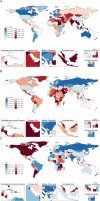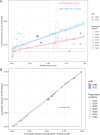Global, Regional, and National Prevalence of Chronic Type 2 Diabetic Kidney Disease From 1990 to 2021: A Trend and Health Inequality Analyses Based on the Global Burden of Disease Study 2021
- PMID: 40400440
- PMCID: PMC12096015
- DOI: 10.1111/1753-0407.70098
Global, Regional, and National Prevalence of Chronic Type 2 Diabetic Kidney Disease From 1990 to 2021: A Trend and Health Inequality Analyses Based on the Global Burden of Disease Study 2021
Abstract
Background: Diabetic kidney disease (DKD) is a prevalent and severe complication of diabetes that significantly impacts global health and quality of life. Most DKD is attributable to type 2 diabetes; therefore, chronic type 2 DKD warrants further examination.
Objective: To deliver targeted assistance in alleviating the worldwide, regional, and national burden of chronic type 2 DKD, we executed a survey assessing the prevalence of chronic type 2 DKD utilizing the Global Burden of Disease, Injury, and Risk Factors (GBD) database.
Methods: We examined the temporal trends of chronic type 2 DKD prevalence over the past 30 years using the 2021 GBD database, analyzed the trends by population, epidemiological change, and aging, and quantified cross-country health inequalities. Additionally, we forecasted the trend during the subsequent two decades.
Results: In 2021, there were over 107 million cases of chronic type 2 DKD globally, reflecting an 85.11% rise from 58 million cases in 1990. The age-standardized rate (ASR) declined with an estimated annual percentage change of 0.17% per annum. Epidemiological change and population expansion are the primary factors influencing the alterations. The contributions of epidemiological change, population, and aging vary with alterations in the sociodemographic index (SDI). Significant health inequalities were observed across 204 countries and territories, with the slope index of inequality increasing over time. The forecast for the worldwide burden of chronic type 2 DKD from 2020 to 2040 suggests a significant rise in case numbers, while the alterations in ASR remain largely stable.
Conclusions: These findings indicate the significant disease burden of chronic type 2 DKD, necessitating more targeted and effective interventions for its prevention and management.
Keywords: GBD; chronic type 2 diabetic kidney disease; health inequality; prediction; trend.
© 2025 The Author(s). Journal of Diabetes published by Ruijin Hospital, Shanghai JiaoTong University School of Medicine and John Wiley & Sons Australia, Ltd.
Conflict of interest statement
The authors declare no conflicts of interest.
Figures




Similar articles
-
Trends and analysis of risk factor differences in the global burden of chronic kidney disease due to type 2 diabetes from 1990 to 2021: A population-based study.Diabetes Obes Metab. 2025 Apr;27(4):1902-1919. doi: 10.1111/dom.16183. Epub 2025 Jan 13. Diabetes Obes Metab. 2025. PMID: 39806549
-
The global, regional, and national patterns of change in the burden of chronic kidney disease from 1990 to 2021.BMC Nephrol. 2025 Mar 13;26(1):136. doi: 10.1186/s12882-025-04028-z. BMC Nephrol. 2025. PMID: 40082779 Free PMC article.
-
Distributions and Trends of the Global Burden of DKD Attributable to Lead Exposure: A Systematic Analysis of GBD from 1990 to 2019.Biol Trace Elem Res. 2025 Jan;203(1):48-60. doi: 10.1007/s12011-024-04156-x. Epub 2024 Mar 28. Biol Trace Elem Res. 2025. PMID: 38546807
-
Trends and cross-country inequalities in the global burden of osteoarthritis, 1990-2019: A population-based study.Ageing Res Rev. 2024 Aug;99:102382. doi: 10.1016/j.arr.2024.102382. Epub 2024 Jun 23. Ageing Res Rev. 2024. PMID: 38917934 Review.
-
Analysis of global prevalence, DALY and trends of inflammatory bowel disease and their correlations with sociodemographic index: Data from 1990 to 2019.Autoimmun Rev. 2024 Nov;23(11):103655. doi: 10.1016/j.autrev.2024.103655. Epub 2024 Oct 2. Autoimmun Rev. 2024. PMID: 39366514 Review.
Cited by
-
Global burden of chronic kidney disease due to hypertension (1990-2021): a systematic analysis of epidemiological trends, risk factors, and projections to 2036 from the GBD 2021 study.BMC Nephrol. 2025 Aug 9;26(1):448. doi: 10.1186/s12882-025-04386-8. BMC Nephrol. 2025. PMID: 40783694 Free PMC article.
References
-
- Saeedi P., Petersohn I., Salpea P., et al., “Global and Regional Diabetes Prevalence Estimates for 2019 and Projections for 2030 and 2045: Results From the International Diabetes Federation Diabetes Atlas, 9th Edition,” Diabetes Research and Clinical Practice 157 (2019): 107843, 10.1016/j.diabres.2019.107843. - DOI - PubMed
-
- Muhammad Haskani N. H., Goh H. P., Wee D. V. T., Hermansyah A., Goh K. W., and Ming L. C., “Medication Knowledge and Adherence in Type 2 Diabetes Mellitus Patients in Brunei Darussalam: A Pioneer Study in Brunei Darussalam,” International Journal of Environmental Research and Public Health 19 (2022): 7470, 10.3390/ijerph19127470. - DOI - PMC - PubMed
-
- Magliano D. J., Boyko E. J., and IDF Diabetes Atlas 10th Edition Scientific Committee , IDF DIABETES ATLAS, 10th ed. (International Diabetes Federation, 2021), http://www.ncbi.nlm.nih.gov/books/NBK581934/. - PubMed
MeSH terms
Grants and funding
LinkOut - more resources
Full Text Sources
Medical
Miscellaneous

